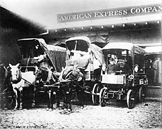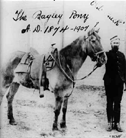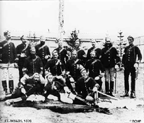

Table of Contents
 One of the most celebrated equestrian events in the United Statesis the National Horse Show, held each November
at Madison Square Garden in New York City. The National Horse Show was begun in 1883, a major event of the
social season. A new addition to the show's schedule in 1909 was the international jumping competition.
One of the most celebrated equestrian events in the United Statesis the National Horse Show, held each November
at Madison Square Garden in New York City. The National Horse Show was begun in 1883, a major event of the
social season. A new addition to the show's schedule in 1909 was the international jumping competition.
Team events were begun in 1911. Although interrupted by World War I, the show again thrived in the 1920s and 1930s.
In the earlyyears of the show, military teams dominated the jumping competition, but civilians now constitute the
majority of entrants. The National Horse Show includes international team jumping, competition for national hunters
and jumpers, saddle seat equitation, and harness competition.
 In 1907, the American Express Company began to replace some ofits horse-drawn delivery wagons with machines.
By 1912, theyboasted 40 gasoline powered and electric wagons, but still had1,300 horses in service. The seven-story
stable in New York Citywas converted to a garage. A new sixty-outlet charging board replenished the electric
wagons' batteries each night.
In 1907, the American Express Company began to replace some ofits horse-drawn delivery wagons with machines.
By 1912, theyboasted 40 gasoline powered and electric wagons, but still had1,300 horses in service. The seven-story
stable in New York Citywas converted to a garage. A new sixty-outlet charging board replenished the electric
wagons' batteries each night.
 On May 23, 1873 the Canadian Parliament authorized the establishment of the North West Mounted Police Force.
Their immediate objectives were to stop the liquor trade among the Indians, halt tribal warfare and attacks on white settlers,
collect customs fees, and perform normal police duties. The vast area for which they assumed responsibility was roughly
composed of the current provinces of Manitoba, Saskatchewan, Alberta, and the Northwest Territories. In the fall of
1874, the first post was established on the banks of Old Man River and was named for the Force's Assistant Commissioner,
James Macleod.
On May 23, 1873 the Canadian Parliament authorized the establishment of the North West Mounted Police Force.
Their immediate objectives were to stop the liquor trade among the Indians, halt tribal warfare and attacks on white settlers,
collect customs fees, and perform normal police duties. The vast area for which they assumed responsibility was roughly
composed of the current provinces of Manitoba, Saskatchewan, Alberta, and the Northwest Territories. In the fall of
1874, the first post was established on the banks of Old Man River and was named for the Force's Assistant Commissioner,
James Macleod.
In stark contrast with the U.S. Cavalry to the south, theNorth West Mounted Police were soon able to gain the trust of the Indians within their domain. This was exemplified in a testimonial delivered by the Blackfoot in 1877.
Throughout the remainder of the 19th century the North West Mounted Police continued to bring law and order to the vast Canadian wilderness. Recognition of their outstanding contributions came in 1904 when King Edward VII proclaimed that the prefix "Royal" be added to their name.
By the outbreak of World War I, the Royal North West Mounted Police had grown to 1,268 officers and men. In 1920 the RNWMP was vested with the responsibility of enforcing all Dominion statutes and its name was changed to the Royal Canadian Mounted Police. Between 1928 and 1950, the RCMP assumed the Provincial Police duties for all Canadian Provinces with the exception of Ontario and Quebec. Today's RCMP is essentially a federal police force with responsibilities similar to those of the Federal Bureau of Investigation.
 The sleek black horses seen in today's musical ride bear little resemblance to the tough work animals once used by the force to
patrol the vast Canadian wilderness. As has happened throughout history, the evolution of the RCMP's horse to his present form
provides graphic proof of the horse's remarkable adaptability to man's specific needs.
The sleek black horses seen in today's musical ride bear little resemblance to the tough work animals once used by the force to
patrol the vast Canadian wilderness. As has happened throughout history, the evolution of the RCMP's horse to his present form
provides graphic proof of the horse's remarkable adaptability to man's specific needs.
 The Mounties First Horses
The Mounties First Horses
One of the first problems confronting the newly formed North West Mounted Police was to obtain and train horses suitable for
the rigors of their western duties. Initially two types of horses were selected, the tough western Bronco and a primarily
Standardbred-type purchased in Ontario. Neither of these horses proved totally satisfactory and so in 1875 the NWMP
first began breeding their own horses.
This soon proved to be too expensive and was turned over to private ranchers. By 1889 specifications for the Force's horses called for; "One standing from 14.3 to 15.2 hands, fine clean cut head, long neck, high chest, broad round quarters with plenty of good flat bone, and strong feet."
The Horses Today
As the equestrian duties of the Royal Canadian Mounted Police shifted from practical to ceremonial, a need was identified to
provide a different type of remount. The result was the reestablishment in 1943 of the RCMP's breeding program to
supply the primarily Thoroughbred-type mares and geldings used in the musical ride.
Since the breeding program began, the RCMP have continued to experiment, introducing the blood of Clydesdales, Percherons, Hanoverians, and Trakehners in an effort to develop a heavier boned, well-mannered, Thoroughbred-type horse. Today's RCMP mount should be black in color, approximately 16 hands in height, and weigh between 1,200 and 1,300 pounds.
 The origins of the famous RCMP's musical ride can be traced to the intricate Prussian Cavalry drills of the 18th century.
The first recorded riding exhibition performed by the NWMP was at Ft. Macleod in 1876, with the first performance
accompanied by music presented in 1887. Since 1966 the only RCMP members to receive equestrian training are those
associated with the ride.
The origins of the famous RCMP's musical ride can be traced to the intricate Prussian Cavalry drills of the 18th century.
The first recorded riding exhibition performed by the NWMP was at Ft. Macleod in 1876, with the first performance
accompanied by music presented in 1887. Since 1966 the only RCMP members to receive equestrian training are those
associated with the ride.
Today's musical ride consists of 32 horses and riders performing numerous intricate figures and always ending in the exciting
charge.
 The entry of the United States into World War I in 1917 tipped the balance in favor of an Allied victory. But long before the
United States sent its men into the struggle, it had sent another resource - its horses. World War I was the twilight of the use
of cavalry. Except for limited skirmishes in the Middle East and the Western front, the cavalry fought mostly on foot.
In previous wars the cavalry swept across a battlefield to surprise an enemy force. But now tangles of barbed wire were
not easily penetrated, and the machine gun could decimate man and horse alike with chilling efficiency. The days of the
offensive horse were ended.
The entry of the United States into World War I in 1917 tipped the balance in favor of an Allied victory. But long before the
United States sent its men into the struggle, it had sent another resource - its horses. World War I was the twilight of the use
of cavalry. Except for limited skirmishes in the Middle East and the Western front, the cavalry fought mostly on foot.
In previous wars the cavalry swept across a battlefield to surprise an enemy force. But now tangles of barbed wire were
not easily penetrated, and the machine gun could decimate man and horse alike with chilling efficiency. The days of the
offensive horse were ended.
 The Death of Millions of Horses in the War Depleted the World's Equine Population
The Death of Millions of Horses in the War Depleted the World's Equine Population
The war used horses in great numbers for non-cavalry purposes. It is estimated that some six million horses served and
substantial numbers of these were killed. By 1914, the British had only 20,000 horses and the United States was called
upon to supply the allied forces with remounts. In the four years of the war, the United States exported nearly a million
horses to Europe. This seriously depleted the number of horses in America. When the American Expeditionary Force
entered the war, it took with it an additional 182,000 horses.
Of these, 60,000 were killed and only a scant 200 were returned to the United States. In spite of the innovations of World War I, one reality remained the same; the horse was the innocent victim.
In one year, British veterinary hospitals treated 120,000 horses for wounds or diseases. Like human combatants, horses required ambulances and field veterinary hospitals to care for the sick and injured. The motorized horse van was first used as an equine ambulance on the Western Front.
Next Exhibit - The Horse in Sport